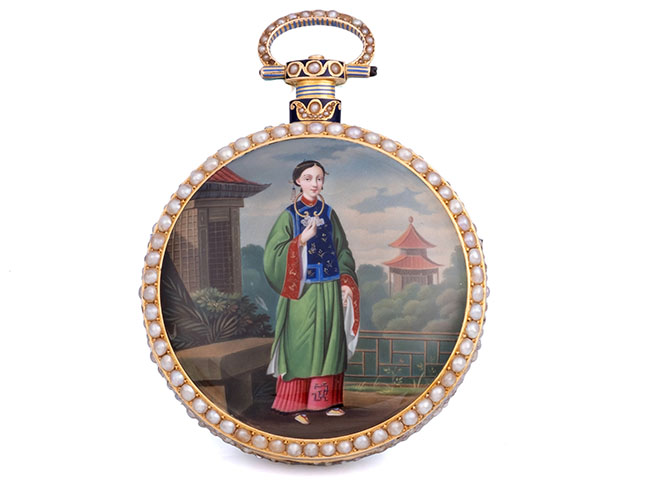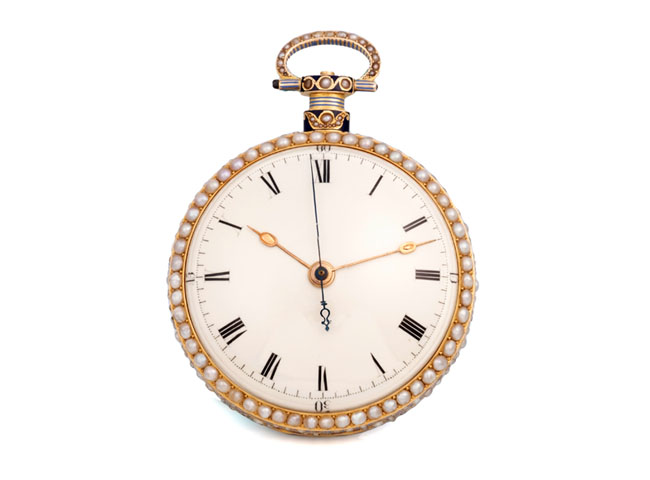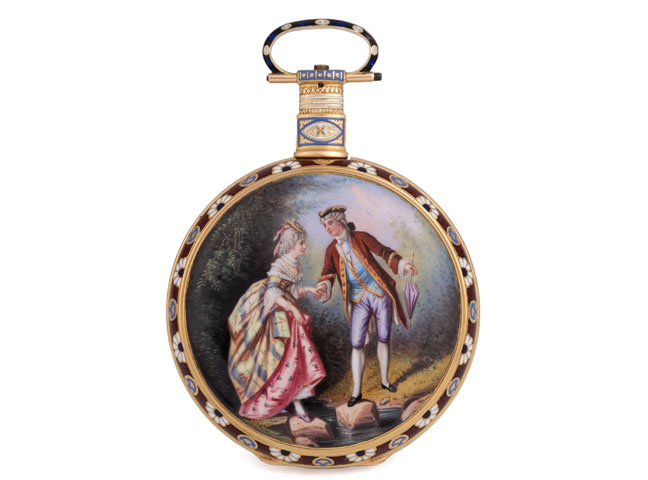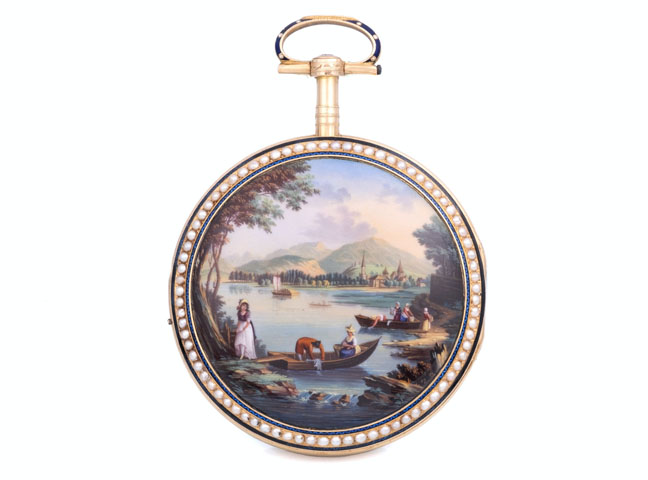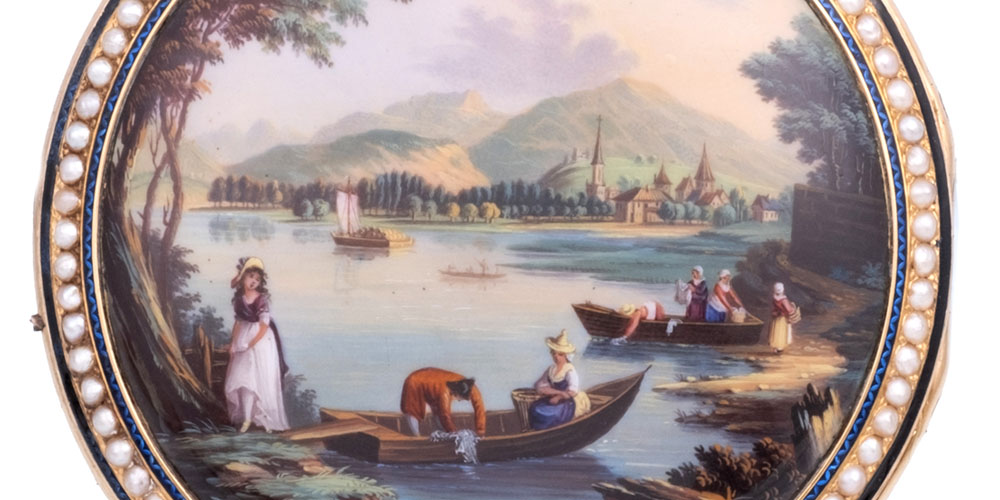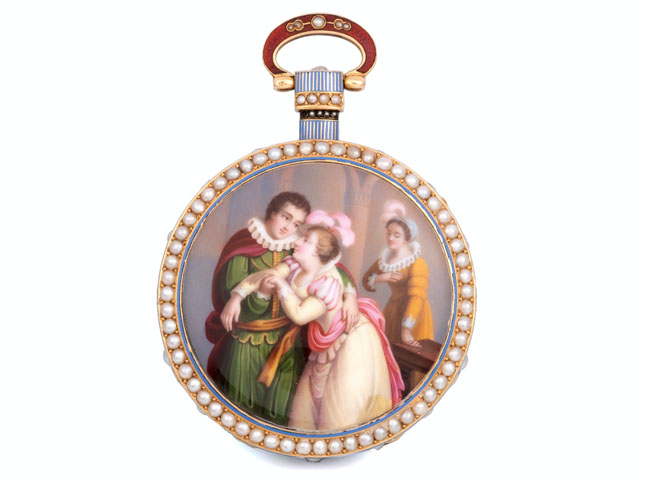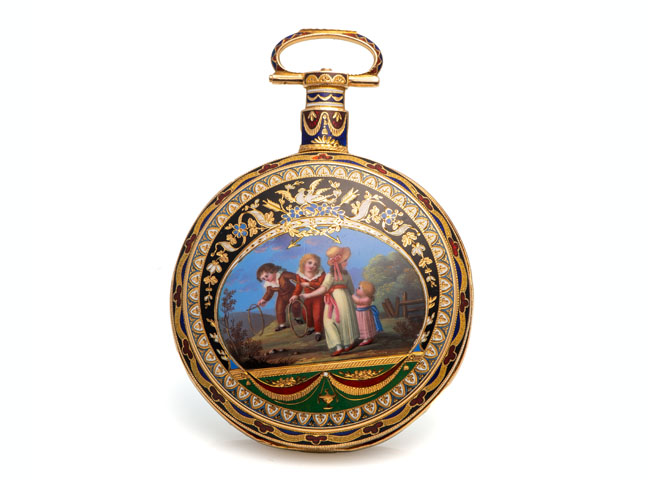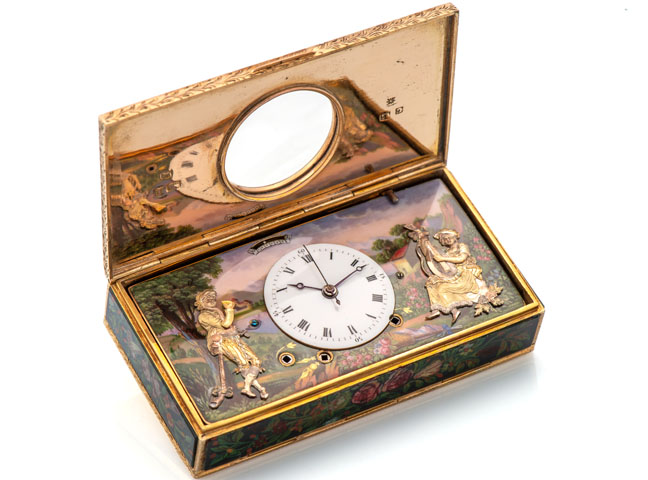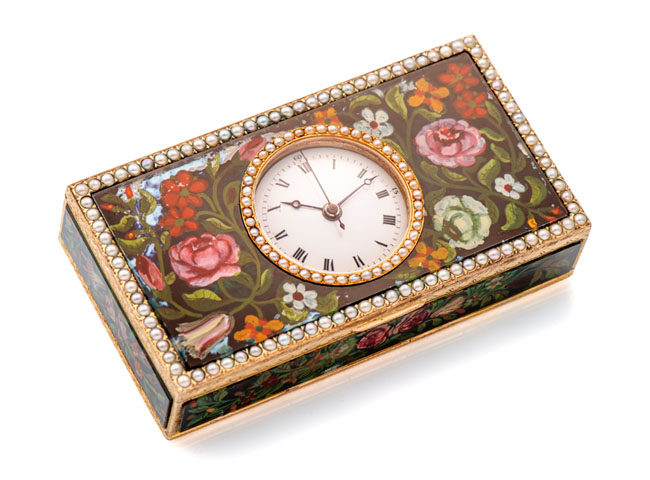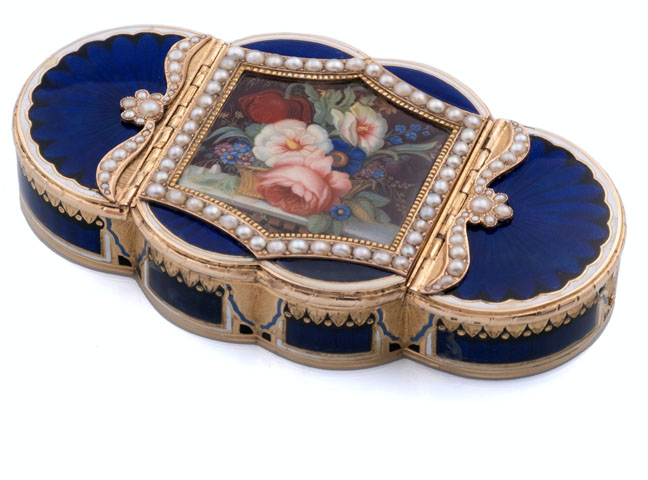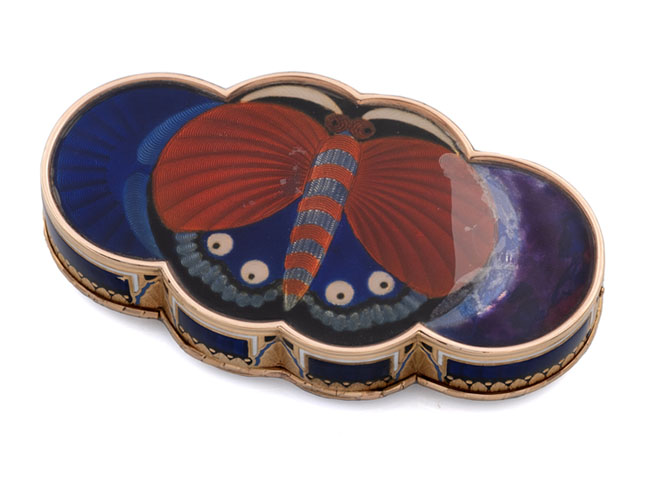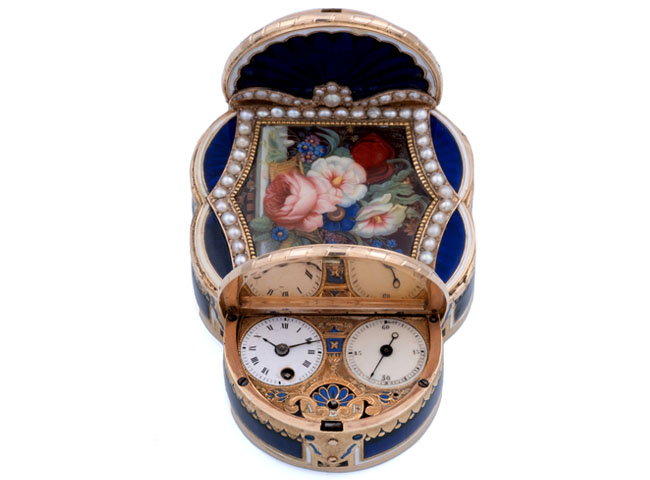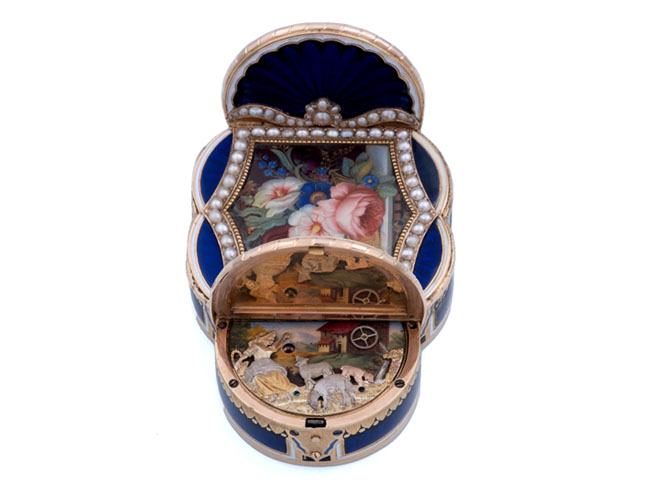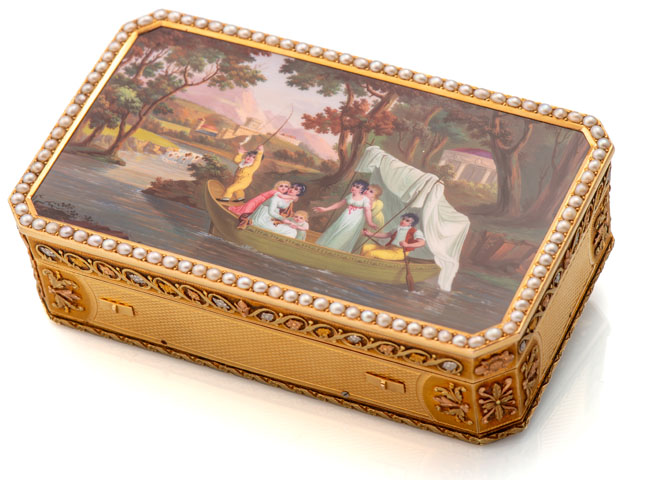Pocket watches for the chinese market
Collection of a swiss gentleman
In the 18th and 19th century, while European aristocrats and rich bourgeois collected Chinese porcelain and lacquer panels, the Middle Kingdom, fascinated by Western watchmaking, bought pocket watches in large quantities, often with rich enamel decoration. These are known today as Chinese watches or watches made for the Chinese market. This collection of Chinese pocket watches has been consigned by one of our oldest and most faithful client. We are presenting just a small part of his collection which will testify, without a doubt, of his impeccable taste.
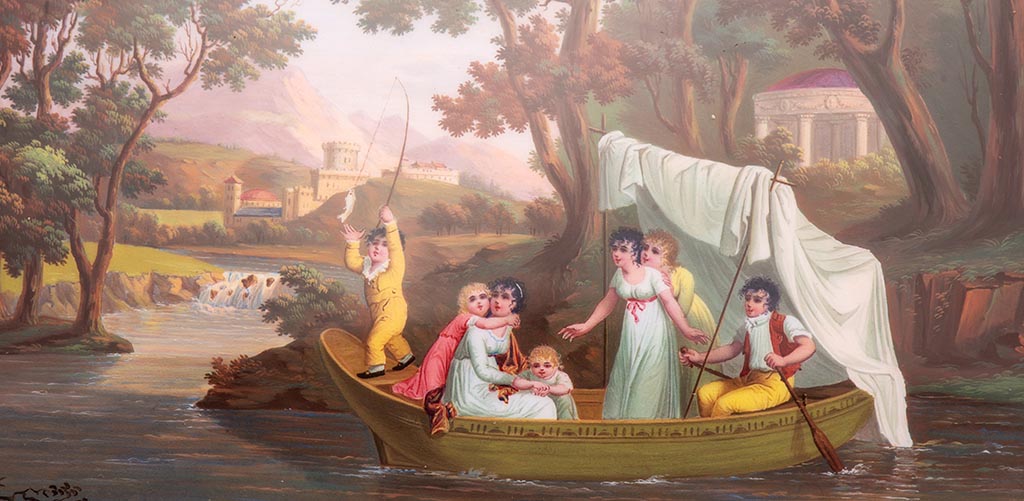
The notion and apprehension of time is primordial. It is what draws the characteristic or even civilizational features of a people. For example, if in the West we have a linear vision of time, this is not the case in the East, more precisely in the Sinic cultures, where time is perceived in a circular sense.
When the first diplomatic relations with China were established, during the reign of King Louis IX of France (1214-1270), animated pieces had their role to play. In 1253 Louis dispatched an ambassador to Manghu Khan, the Grand Khan of Tartary. This was the epoch of the great Mongol incursions which swept over Russia as far as Kiev, and southward as far as Poland and Hungary. An account of the voyage by the King’s ambassador, Guillaume de Rubruquis, a Flemish priest and traveler, is conserved in the British Museum. Originally in Latin, it was translated into English in 1629 and into French in 1839. This document states that among the prisoners of the Tartars at Karakarum was a certain Guillaume Boucher, a skilled goldsmith from Lyon who won the favor of the emperor of Tartary by constructing for him a monumental and marvelous automaton. Four silver lions lay at the foot of a great tree with boughs bearing silver leaves and fruits, and mare’s milk flowing from their half-opened jaws. On the inside, four conduits rose to the top of the tree and descended in the form of gilded serpents. Out of their mouths ran precious liqueurs to fill silver vessels. At the top, an angel sounded a trumpet when the cupbearer gave the order to pour out the draught. The apparatus was activated by means of a bellows worked by a man hidden in the base of the tree. Servants replenished nearby reservoirs with the liqueurs for the respective conduits.
Although the first connections between China and the West were established in the 13th century, the first clocks and watches were imported via Portuguese trading posts in the 16th century (1514), under the Ming dynasty, especially with the Jesuits ‘arrival in Beijing, such as Father Matteo Ricci (1552-1610). Timepieces have long been gifts of predilection. Symbols of power, of knowledge, messengers of culture, tokens of friendship, and gauge of peace, they never failed to astonish and to please.
At the threshold between these two worlds, pocket watches destined for the Chinese market are a splendid testimony to Swiss know-how exported abroad as early as the 18th century. They are sought after by many collectors due to the richness of the engraved and enameled decorations, punctuated by seized golds and surrounded by half pearls. Actually, these orders were extended to an important part of Asia, in India or Persia. The two main production centers for pocket watches destined for the Chinese market were London and Switzerland.
During the 18th century the English made significant efforts to expand their trade through China. London clock-makers played a prominent role in the popularity of ‘Curiosities’ so admired by the Chinese. The English East India Company, created in 1600, seized control of large parts of the Indian subcontinent, colonized parts our Southeast Asia and Hong Kong. Strong commercial and diplomatic ties between Britain and the Chinese court ensured that many watches, despite being of Swiss origin, were signed with English names and marked London.
British hallmarks were sometimes faked or imitated, especially in the 18th and early 19th centuries when English watchmaking enjoyed a reputation as the finest there was. Marks looking like British hallmarks were out into watchcases to lead people to think that a watch was of English make. Sometimes pseudo ‘‘hallmarks’’, marks that were meant to look somewhat like hallmarks without trying to be out-and-out fake hallmarks, were stamped in order to make a case look more impressive. Most of the time these pocket watches were made in China, in silver or gilded silver, but with the same characteristics as the pocket watches made in Europe for the Chinese market.
However the Continental Blockade, from 1806 to 1814, broke the relationships between Geneva and London. After 1815, the workshops of Piguet & Meylan, Jaquet Droz & Leschot in Geneva, James Cox or Ilbery in London and Bovet in Fleurier distinguished themselves by the quality of their creations, often enameled in Geneva. At its peak around 1840, trade, although disrupted by the opium wars, continued with Switzerland. The influence of Edouard Bovet was such that “Bo Wei” is the Cantonese word for “watch” itself. Contrary to one might think, Western watchmakers did not adopt forms from their intended market. Chinese taste matched the European style with fantastical forms, arabesque floral arrangements with colorful gem set borders.
After the Boxer Rebellion in 1900, and then the Socialist Revolution, most of the collections were sold.
TO BE PRESENTED IN GENEVA MAY AUCTION 2023
Preview : May 10th – 15th
Antiquorum Genève SA
3 rue du Mont-Blanc
1201 Genève
Auction : May 14th – 15th
Sunday May 14th at 5PM – 1st session
Monday May 15th at 10AM – 2nd session
Monday May 15th at 2PM – 3rd session
Hôtel Beau-Rivage – Salon de l’Impératrice
13 Quai du Mont-Blanc
1201 Genève
Ilbery London, Switzerland, CHINESE YOUNG LADY DRESSED IN FORMAL COURT COSTUME, made for the Chinese market, circa 1820
Estimate : 60.000 – 100.000 CHF
Very fine and extremely rare 18K gold and enamel, pearl-set, centre-seconds watch with duplex escapement. Empire case, the split-pearl set bezel, pendant and bow with blue and azure champleve enameled decoration the scarlet flinque enameled band with split-pearl inlaid decoration, the enamel back panel painted with the portrait of a Chinese noble lady on a balcony in a Chinese landscape.
William Ilbery, London, recorded as working in 1780, died 1839.
Specialized in watches for the Chinese Market, and worked closely with contacts in Switzerland both for movements and enamel work. The political and commercial relations between Britain and China were so essential, that even the exceptionally talented Jaquet-Droz established a branch in London to take advantage of the China trade. The best period of watchmaking for the Chinese Market coincides with Ilbery’s success – in 1790 – 1830 – and with the work of the finest enamel artists – Dupont, Richter, Lissignol etc. Almost without exception, the subjects depicted on these cases were taken either from classical mythology, Swiss landscape painting, or based on stories of an allegorical nature – Faith, Hope, Love etc. Examples with a portrait are virtually unknown for the time, and until the watch now offered for sale appeared, only one other was apparently known to have survived. At the Christie’s auction of April 20, 1991 in New York – Important Clocks and Watches, lot 89 was a virtual pair to the current lot, but with the back panel depicting a portrait of a Chinese gentleman, also dressed in formal Court costume (present whereabouts currently unknown). Although not a pair in the generally accepted sense (ie. the identical subject but painted in reverse), they must originally have been commissioned for the saute customer and presumably the couple depicted in the portraits. Frequently sequential numbering of the movements can be found on ‘pairs’ of watches, but it does not appear to have been an infallible rule. Since there is no tradition of Swiss enamellers working in China at the beginning of the 19th century, it is interesting to speculate as to how the ‘master’ portraits were communicated to Europe. Towards the end of the 19th century, photography was used, and drawings do exist from the 1860’s or later (see A. Chapuis, la Montre Chinoise, Neuchatel, p.187, fig.148). In view of the rich colouring of the costume, and the incorporation of flecks of gold to simulate braid, it seems possible that the portraits may have been taken from glass paintings, a technique that enjoyed considerable popularity in China. Plate glass mirrors were exported from Europe to be partially decorated with the same technique and returned for framing in the chinoiserie style.
Edouard Juvet, Switzerland, THE NOBLEMAN, made for the Chinese market, circa 1870.
Estimate : 40.000 – 60.000 CHF
Very fine 18K gold and enamel centre-seconds watch, with duplex escapement.
Pendant and bow with champleve enamelled decoration, the back enamel panel with a fine painted scene depicting a nobleman helping his loved one to cross the stream. Hinged polished-gold cuvette with bright cut and engraved decoration. The scene depicted in the neo-rocaille, neo-Louis XV style, which was very in vogue in the 19th century, demonstrates the taste of the Chinese market for this type of motif.
Edouard & Léo Juvet
One of the important Swiss horological families working for the Chinese market. Edouard Juvet (1820-1883) was first established in Buttes in 1842, but in 1844 moved his workshop to Fleurier. He began making ”Chinese” watches in 1856. Edouard’s sons Ami-Louis and Léo traveled to China to work in the family firm. When Ami-Louis died there, Léo (1848-1891) took his place. In Shanghai, the Juvets were rivaled only by the Bovets, yet the two families maintained friendly relations. The Maison Juvet prospered, opening branches in Tien-Tsin and Saigon, to the extent that in 1872 Léo wrote : “Our watches sell like salt”. In 1873, Edouard Juvet registered a trademark in Chinese characters, which was used on the company’s products. He granted his son Léo power of attorney in November 1875, and after his death in February 1883, Léo succeeded him at the head of the firm.
Ilbery London, Switzerland, CALM HARBOR, made for the Chinese market, circa 1820
Estimate : 60.000 – 100.000 CHF
Fine and very rare, 18K gold, painted on enamel and pearl-set pocket watch with duplex escapement. The enamel attributed to Jean-Louis Richter. “Empire” style case, the hinged back decorated with a finely painted view in the manner of Claude Vernet of people washing their clothes from a boat in a calm harbor landscape with mountains and a small village in the distance. Hinged and sprung gold cuvette attached to the movement ring.
Jean-Louis Richter (1766-1841)
Learned his art under David-Etienne-Roux and Philippe-Samuel-Théodore Roux, becoming a most renowned enamel painter. His specialty was the painting of landscapes and particularly lake-side scenes and marine-scapes, often representing ships in a harbour or battles with fighting Men-of-War, but, on occasion, also portraits and hunting scenes. He did not often sign his work, but it is clearly recognised as being in his hand from the style and quality of the painting. He applied his art principally to watch cases and snuff boxes and these were largely destined for the Chinese, Turkish, British and Italian markets. In 1828 he was in partnership with Aimé-Julien Troll (1781-1852) and one can find work signed? Richter et Troll?. Richter, like other great enamel painters of the time, often found inspiration for his work from paintings or engravings by the artists then in fashion particularly Claude Vernet.
William Ilbery (ca. 1760-1839)
Active in London from 1780 in Goswell Street, he moved to Duncan Terrace towards the end of the 18th century. Following James Cox in London and Jaquet Droz in Switzerland, he also specialised in the production of luxury watches for the Chinese Market. His early production was very much in the English style, featuring a full plate movement and an English type single wheel duplex escapement. However, for his highest quality watches, he incorporated a spring detent escapement. Later, the watch movements he produced were much inspired by the Lepine caliber with free-standing barrel, as were Jaquet Droz’s Swiss production signed in London and that of William Anthony, who worked in London. The cases of his watches were sumptuously decorated by the best Genevan enamelers, such as Jean-Francois-Victor Dupont, who usually signed his work, and Jean-Louis Richter, who signed rarely. He organized the production in Switzerland, mainly in Fleurier, of profusely engraved movements for the Asian market. He was followed in this by makers such as Bovet and Juvet who also worked in Fleurier (Val de Travers). Ilbery can therefore be considered one of the most representative makers of ”Chinese” watches. He seems to have maintained close contacts with the continental trade since a watch signed ”Ilbery Paris” is known and Ilbery & Son are recorded in London and Fleurier, as well as in Canton.
Bovet Fleurier , Switzerland, THE SHAKESPEARIAN TRAGEDY, made for the Chinese market, circa 1824
Estimate : 50.000 – 100.000 CHF
Very fine and important 18K gold and enamel pearl-set watch, made for the Chinese market. Empire shaped case with split-pearl set bezels and pendant, the band and bow of red translucent enamel over engine-turning with split-pearl inlaid decoration, the back enamel panel finely painted with a scene of a Shakespearian Tragedy. Hinged gold engine-turned cuvette.
“The Shakespearian Tragedy”
Although their movements were generally produced in Fleurier (Val de Travers), Switzerland, these top quality watches, made for the Chinese Market during the first quarter of the 19th century, were decorated in Geneva by the best craftsmen of the time. Enamel painters such as Richter and Dupont used to find their inspiration in the work of old master painters such as Van der Myn (1684-174 I ), Giovanni Batista Cipriani (I 727-1785), John Francis Rigaud (1742-1820), John 1-loffner (1748-1810, Francesco Bartolozzi (1727-1815 and William Hamilton) . The enamel back of each single case is in itself a true master piece of miniature painting featuring seaside landscapes, naval battles, mythological and allegorical scenes evoking love, such as “The rapt of Helen by Paris” taken from the engraving by Guido Reni (1575-1642), children at play, and illustrations of Shakespearian Tragedies.
Bovet
A watchmaking dynasty founded by Edouard, Frédéric, Alphonse, Gustave, Charles-Henri, and Caroline Bovet, of Fleurier. In 1822, a Bovet partnership was founded for the Chinese watch trade in Canton. In 1840, Bovet Frères et Cie was established in Fleurier, and in 1864, the Bovet watch production was sold to Bovet’s manufacturing inspectors in Fleurier, Jules Jéquier and Ernest Bobillier, soon joined by Ami Leuba. In 1888, Bovet Frères was founded under the direction of Alexis Landry, who served his apprenticeship in Fritz Bovet’s workshop in Fleurier, producing ebauches for Chinese watches and silver cases. Alexis Landry formed a partnership with Albert and Jean Bovet, specializing in complicated watches and chronographs. In 1901, the Bovet trademark was acquired by César and Charles Leuba, sons of Ami Leuba. In 1918, Jacques Ullmann & Co. of La Chaux-de-Fonds bought the Bovet brand from Leuba Brothers, and in 1948, Favre-Leuba took over the company and acquired the first production plant. In 1966 Favre-Leuba sold the Fleurier plant, and in 1989 Parmigiani acquired the Bovet name.
A limited company registered as Bovet Fleurier S.A. was formed in 1990, using the Bovet trademark. In 1994, Roger Guye and a partner bought Bovet Fleurier S.A. and opened a branch in Geneva. Pascal Raffy became the majority shareholder and President in 2001. Today, Bovet timepieces are widely available in the world’s major destinations. Eager to maintain its historical roots in the Far East, the company has subsidiaries in Hong Kong and Japan, and delivers its collection to select distributors in Singapore, Taiwan, the Middle East, Turkey, Russia, the United States, London, and Geneva.
Ilbery London, Switzerland, ILBERY, SOLID GOLD MOVEMENT WITH RICHTER ENAMEL SCENE, made for the Chinese market, circa 1810
Estimate : 40.000 – 80.000 CHF
Very fine and rare, pocket watch made for the Chinese market, special “solid red gold” movement; 18K yellow gold and enamel; the enamel attributable to Jean-Louis Richter. 18K yellow gold and enamel, open-face, key-winding, round-shaped, pocket watch with special solid gold movement and subsidiary seconds at 6.
An Extraordinary Discovery
This watch is the “sister” of a piece we sold in this same auction room in Hong Kong on April 28, 2019 (lot 607).
The enamelled scene of the two watches is mirrored; the image being reversed like the reflection of each other in a mirror. This is one of the specificities of the Genevan production for the Chinese market, which often passed through the London trade before being exported to the Middle Kingdom. It is also worth noting that both of these timepieces are equipped with extraordinary movements built in solid gold. We are thus dealing here with one of the summits of the history of watchmaking at the beginning of the 19th century.
The watch is accompanied by a box with two places, expressly made to keep the two pieces together. On the back of this box is an antique label with a handwritten inscription: “Numa Jacot / Fleurier”. This may be the name of a former owner of this pair of watches, now separated from each other but hopefully reunited one day. It is difficult to say whether this box dates from the time of the production of the watches or rather from the middle of the 19th century; probably the time of their return to Europe following the vicissitudes of the Celestial Empire in the 19th century.
Some enlightened amateurs will tell us that the numbers of the movements are not consecutive, that they cannot be pieces born together, like two twins. The studies we have been conducting on so-called “Chinese” watches for decades lead us to reply that if this seems illogical, it is not impossible. This is all the more true since we are dealing here with extremely rare movements whose production must have taken much longer than that of classic “Chinese” movements. Several pairs of watches preserved in the Patek Philippe Museum in Geneva demonstrate this because the numbers of their movements are not consecutive.
Note also that this pair of watches is the only one known to date with gold movements. In fact, we have listed only seven of these movements, four of which are signed by “Ilbery London”. Despite this signature, we know today that this production is entirely from Geneva.
For more information, we refer our readers to our 2010 exhibition catalogue: Tellier, Arnaud, & Didier, Mélanie, The Mirror of Seduction, Prestigious pairs of “Chinese” Watches, Geneva, Patek Philippe Museum Editions, 2010.
William Ilbery (c.1760-1839)
Active in London from 1780 in Goswell Street, he moved to Duncan Terrace towards the end of the 18th century. Following James Cox in London and Jaquet Droz in Switzerland, he also specialised in the production of luxury watches for the Chinese Market. His early production was very much in the English style, featuring a full plate movement and an English type single wheel duplex escapement. However, for his highest quality watches, he incorporated a spring detent escapement. Later, the watch movements he produced were much inspired by the Lépine calibre with free-standing barrel, as were Jaquet Droz’s Swiss production signed in London and that of William Anthony, who worked in London.
The cases of his watches were sumptuously decorated by the best Genevan enamelers, such as Jean-Francois-Victor Dupont (1785-1863), who usually signed his work, and Jean-Louis Richter (1766-1841), who signed rarely. He organized the production in Switzerland, mainly in Fleurier (Val-de-Travers), of profusely engraved movements for the Asian market. He was followed in this by makers such as Bovet and Juvet who also worked in Fleurier. Ilbery can therefore be considered one of the most representative makers of ‘‘Chinese’’ watches. He seems to have maintained close contacts with the continental trade since a watch signed ‘‘Ilbery Paris’’ is known and Ilbery & Son are recorded in London and Fleurier, as well as in Canton. His son, William Ilbery (c.1780-c.1851), works with him.
The case of our watch is made in the same spirit as that of the watch signed Ilbery, London, No. 5 995, whose movement (gilded brass, full plate, with fusee and chain) is fitted with a spring detent Peto cross escapement. The enamel painting, also attributable to Jean-Louis Richter, represents a scene with children “Feeding the Chicks”. This case is also of “Consular”-type with scalloped edges (see: Antiquorum, Geneva, auction, April 13, 2002, lot 61, sold for the amount of CHF 245 500.-). Ilbery seems to have used this type of case only for its more luxurious watches; those with “chronometer” movements or “solid red gold” movements.
Only very few Ilberys watches with “solid red gold” movements are known to-date. This is the fourth movement known duly signed by Ilbery, London. The others are unsigned. All cased with painting on enamel attributable to Jean-Louis Richter, Geneva .
The charming painted enamel scene decorating the present watch derives from English genre paintings by artists from the Royal Academy, such as Joshua Reynolds (1723-1792), Francis Wheatley (1747-1801), William Hamilton (1751-1801), William Redmore Bigg (1755-1828), George Morland (1763-1804), etc., who specialised in images of romanticised English rural life in the last quarter of the 18th century.
Their paintings were engraved by Francesco Bartolozzi (1727-1815), Thomas Burke (1749-1815), John Raphael Smith (1752-1812), Peltro William Tomkins (1760-1840), Henry Gillbank (fl. late-18th and early-19th c.), Thomas Gaugain (1756-c.1810), etc., and sold as prints which were published by John Boydell (1719-1804) and Josiah Boydell (1752-1817), engravers and print-sellers, James Daniell (fl.1771-1814), John Brydon (fl.1783-1806) and others.
These genre prints were enormously popular and were used as models for Genevan enamelers, including Jean-Louis Richter (1766-1841).
Objects of Virtue
These watches, made for the Chinese market, testify to an exceptional know-how which is nowadays inherited by the craftsmanship – “Métier d’art” – departments of the manufactures. This craze for rich enameled decorations and cases set with pearls and gems extended to a whole range of objects of virtue – “objets de vertus” –, also known as vitrine objects, such as snuffboxes and music boxes.
Attributable to Piguet et Meylan, Switzerland, AUTOMATON AND MUSICAL SNUFF BOX, made for the Chinese market, circa 1820
Estimate : 40.000 – 80.000 CHF
Very fine and unusual 18K gold and enamel pear-set snuff box with eglomise glass panels, built-in centre seconds watch and musical automaton scene. Rectangular shapped case with English prestige marks, eglomise (under painted on glass) panels painted with flowers over a black ground, the lid with split-pearl set borders and bezel. Enamel dial plate finely painted with a country landscape and applied on each side of the dial with a three-coloured gold sitting lady on the right, playing the mandolin, a standing boy on the left beating time in unison.
Philippe Samuel Meylan Born February 15, 1772, in Bas-du-Chenit, died in 1845.
At 20 years old he came to Geneva where he worked for the Godemar Frères in quality of Master worker. Afterwards he went back to Brassus where he founded a little factory in 1811. He then returned to Geneva where he definitively settled. He met another watchmaker from his own village, Isaac Piguet, with whom he entered into partnership, founding the Piguet & Meylan firm, which would last from 1811 to 1828. It specialised in minute cadratures, musical watches, skeleton or automaton watches, mechanical animals and figures, he is also credited with the invention of the bagnolet caliber. Isaac Daniel Piguet. Born in 1775 in Le Chenit in the Vallée de Joux, Isaac Daniel Piguet was the son of Pierre Moïse Piguet and Elisabeth Nicole. He married Jeanne Françoise Capt around 1795, and around 1800 settled in Geneva with his family. Isaac Daniel Piguet went into business with Henry Daniel Capt, his brother-in-law, on February 10, 1802. The association between Piguet & Meylan came to an end in 1828. Piguet and his son David Auguste established a new company, Piguet père & fils, located no 69 rue Jean-Jacques Rousseau. Isaac Daniel Piguet died in Geneva, on January 20, 1841, at the age of 66. he sur plateau musical arrangement, as found in this box, is attributed to Philippe Meylan. The blades are laid out at angles of equal intervals, and they move progressively inward toward the center of the disc. The teeth playing the higher notes, since they are stiffer, are acted upon by the pin near the center of the disc, the lower notes are played by the more easily flexed blades set nearer the periphery of the disc. The number of the blades usually varies between 16 and 27 but usually several notes are duplicated. The present box features Meylan’s invention as well as typical Piguet et Meylan automaton arrangement, with the center-seconds cylinder watch movement set directly on the same plate as the musical one. In addition, the enamel on the dial plate has most of the characteristics found on other Piguet et Meylan dial plates.
Attributed to Piguet & Capt., Switzerland, BASKET OF FLOWERS, made for the Chinese market, circa 1820
Estimate : 70.000 – 130.000 CHF
Very fine and important, gold and enamel, pearl-set, snuff box with a concealed watch and automaton. Case with three compartments: the central compartment for the snuff, having a lid decorated with a finely painted basket of flowers within a half pearl border. The side compartments with spring-loaded covers, the left one for the automata and the right one for the watch, both covered with predominantly royal blue translucent enamel over ‘sunburst’ engine-turning with borders in white enamel and half pearls, the sides en suite. The bottom painted with a butterfly with open wings in translucent red enamel against royal blue translucent enamel, the same as on the sides, over engine-turning. Under the left lid is an automaton pastoral scene with a shepherdess raising and lowering her hand, feeding a lamb which moves its head up and down; in the front a grazing sheep nods its head and a dog with animated head drinks from a stream running from the mill, with turning waterwheel and a small waterfall simulated by a twisted glass rod. All figures in multicolores gold and silver, set polychrome enamel painted scene over gold. Under the right lid is the watch.
A box of identical shape, with identical automaton and watch movements, was in the Pierpont Morgan Collection, described in the catalogue under No. 85, and is now in the Metropolitan Museum of New York. Another one is preserved in the Sandoz Collection, described by Alfred Chapuis and Edmond Droz in ‘Les Automates’, plate VII and p.180.
Specialised in the production of complicated watches, musical and/or automaton scenes incorporated into watches, snuff-boxes or objects. Among the first in Geneva to use the musical mechanism with pinned cylinder and tuned teeth comb. From Ventôse 16, An X (March 7, 1802), to 1811, Henry-Daniel Capt (1773-1841) formed a partnership with Isaac-Daniel Piguet (1775-1841), who was from the same village – Le Chenit – as he in the Vallée de Joux. Their signature was Piguet & Capt. In 1811, when Piguet broke off to join Philippe-Samuel Meylan (1772-1845) in a new partnership, Henry-Daniel Capt continued to work on his own until, in 1830, he went into partnership with Aubert and Son, Place Bel-Air. Their signature was Aubert & Capt. They were among the first Genevan makers to produce watches with chronograph. In 1844, the workshop was at 108, rue Neuve in Geneva. It was then managed by Capt’s son, Henry Capt Jr. After a short time it moved to 85, rue de la Fusterie, and in 1851, to 177, rue du Rhône. In 1880, the firm was bought by Gallopin and its name became H. Capt Horloger, Maison Gallopin Successeurs, a trademark registered on November 1, 1880, under the No. 44. This signature was only used for watches retailed in their own store, the watches supplied to other retailers being merely signed Henry Capt. Henry-Daniel Capt, along with Isaac-Daniel Piguet and Philippe-Samuel Meylan, was the foremost maker of small musical automata in the late 18th and early 19th centuries. Most of his work is not signed, although he sometimes scratched his name on his movements.
Provenance:
Published in the Sandberg book, pages 418-419. Lot 201 from the Sandberg collection.
Jean-Louis Richter, Switzerland, RICHTER ”RIVERSIDE LANDSCAPE” 18K FOUR-COLOURED GOLD, circa 1830
Estimate : 50.000 – 100.000 CHF
Very fine and important 18K four-coloured gold and enamel, pearl-set musical snuff-box. Rectangular case with canted corners, the enamel panel of the lid with split-pearl set borders, finely painted by Richter with a riverside landscape, a castle and mountains on the back, a rowing boat on the foreground with a family enjoying a nice afternoon. Engine-turned side and back panels with four coloured gold floral and foliage decoration chased over a matted ground.
Jean Louis Richter (1766-1841)
He learned his art under David-Etienne-Roux and Philippe-Samuel and Theodore Roux, becoming a most renowned enamel painter. His specialty was the painting of landscapes and particularly lake and marine scapes, often representing ships in a harbour or battles with fighting Men-of-war but, on occasion, also portraits and hunting scenes. Although it may happen that his signature, running hand-writing, appears on some of his work, more often than not his paintings are unsigned but can clearly be recognized as being in his hand from the style and duality of the work. He applied his art principally to watch cases and snuff boxes and these were largely destined for the Chinese, Turkish, British and Italian markets. In 1828, he was in partnership with Aimé-Julien Troll (1781-1852) and one can find work signed Richter et Troll.
Richter, like other great enamel painters of the time, often found inspiration for his work from paintings or engravings by the artists then in fashion, particularly Claude Verne, Van der Myn (1684-1741), Giovanni Battista Cipriani (1727-1785), John Francis Rigaud (1742-1820), John Hoffner (1748-1810) and Francesco Bartolozzi (1727-1815), or even from the romanticised English and Irish rural life or particularly famous scenes such as the ” Rape of Helen ” from the engraving by Guido Reni (1575-1642), now in the Cabinet des Estampes, Paris.

